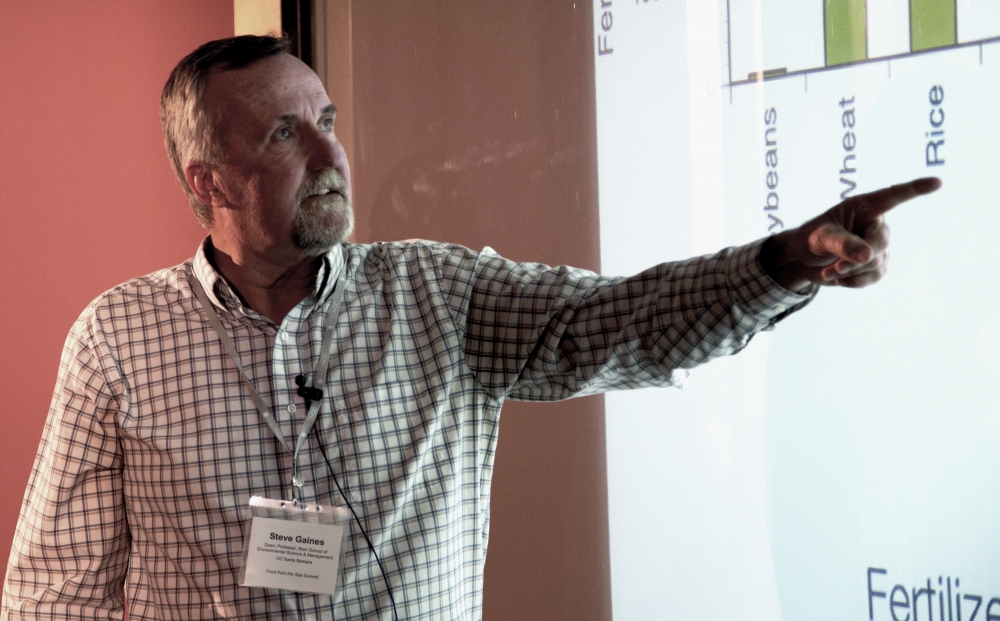20 Environmental Challenges. 20 Projects. 20 Solutions

How can wolves and humans co-exist in California? How can UCSB become carbon neutral by 2025? How can whale strikes by container ships be prevented in the Santa Barbara Channel? How can brewery waste be turned into packaging profitably? What is the best way to rezone the Galápagos Marine Reserve?
Students from the Bren School of Environmental Science & Management will offer answers to these and other environmental questions Friday, April 29, when they present the results of their capstone Master’s Projects to a public audience at the Fess Parker Doubletree hotel in Santa Barbara.
Master’s projects of two kinds ― group projects and eco-entrepreneurship (Eco-E) Projects ― are a defining and distinguishing element of the Bren School master’s curriculum. All Bren master’s students are required to complete a project and present their findings publicly, a process that provides them with unparalleled professional training.
“We hear a lot about the incredible diversity of environmental problems we face,” said Bren School dean, Steve Gaines. “Those who attend this event will be amazed by the kinds of things Bren students work on and the solutions they develop. The projects demonstrate that by tapping the talents of creative students, we can see highly innovative solutions develop faster than the problems, while launching problem-solvers into careers where they will continue to improve the world.”
In group projects, teams of three to five students spend the better part of a year collaborating with each other and with a client ― typically a corporation, an NGO, a government agency, and even UCSB ― to develop a solution to an actual environmental challenge facing a real-world client. Students working on Eco-E projects develop a business model to bring to market a product or service that addresses both a consumer and an environmental need. Each year in April, the students present their group project findings and their Eco-E business models to an audience of project clients, faculty, friends, family and interested members of the UCSB and greater Santa Barbara communities.
These are not hypothetical case studies, but rather real, valuable consulting work for clients who have a stake in the outcome and have come to rely on the Bren School to provide comprehensive solutions to problems they may not have the time or expertise to address.
Working with their faculty advisors, the Bren students bring wide-ranging interdisciplinary skills to the projects. And, as Bren professor John Melack noted in a recent group project video, “They come up with solutions that not even big corporations have thought of themselves.”
“I tell students that the work they did on their group projects as students is guiding work that I do today,” says E. J. Remson, senior program manager for The Nature Company, which has been the client for seven group projects. Most recently, in 2013, students developed floodplain conservation strategies for the lower Santa Clara River, which meets the ocean between Ventura and Oxnard. The stakes were high, because the students’ analysis was an early deliverable on a $4.5 million project.
“I had full confidence in them, but if for some reason it had fallen apart, I’d have been in trouble,” Remson said recently. “The work product was absolutely excellent, and I told many people that if we had paid a consultant a lot of money and they had produced that work product, I’d have been happy with it.”
Sean Hastings is resource manager for the Channel Islands National Marine Sanctuary (CINMS), which is administered by the National Oceanic and Atmospheric Administration (NOAA). He regularly hires Bren graduates and has been the client for several group projects, including this year’s whale-strike project.
“Each group project brings me four to five eager, interested, capable master’s students who are perfectly trained to work with us,” Hastings said. “They are groomed through the rigor of their academic program and the statistical and GIS and ecological coursework they take, the negotiation skills they learn and their group projects. That perfectly suits them for public service and working specifically within NOAA. They can work anywhere, but honestly, selfishly, I like training them up to come to NOAA. We need the best and brightest to do this conservation and management work.”
In 2014-15, the NGO Defenders of Wildlife became a client for a group project that developed an optimization plan for siting utility-scale solar installations in California’s Central Valley. Two of the students in that project ended up in Gov. Jerry Brown’s office, presenting their findings to a group of high-level stakeholders from utilities, farms, environmental groups and government agencies.
This year, the Defenders returned as a client for the project in which Bren students prepared recommendations on how to minimize the human-wolf conflicts resulting from wolves’ returning to Northern California.
“Every time we’ve interacted with people from Bren, we’ve found them to be extremely professional, very good at what they’re doing and very focused,” said Kim Delfino, Defenders of Wildlife California program director. “They produce high-quality work and approach problems in a very practical way. Science is moving quickly, and it’s challenging to stay on the cutting edge. The students bring fresh perspectives and new technologies, and we learn quite a bit. The school does an excellent job of training graduates to go immediately into conservation work at the highest level.”
UC Santa Barbara, too, has been a repeat client, and group projects have addressed a range of sustainability issues, from energy and water efficiency to food and solid waste. For this year’s project, students developed a plan to meet UC president Janet Napolitano’s mandate that the campus be carbon neutral by 2025. A previous project was used to establish UCSB’s long-term water-use strategic plan and helped to inform plans adopted by other UC campuses, also in response to a mandate from the UC Office of the President.



